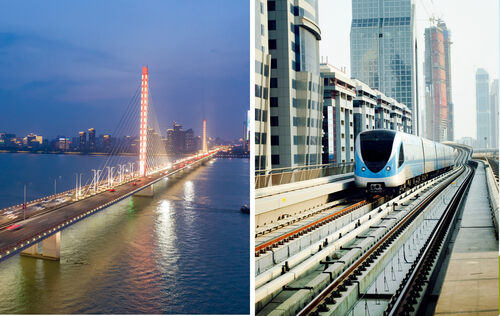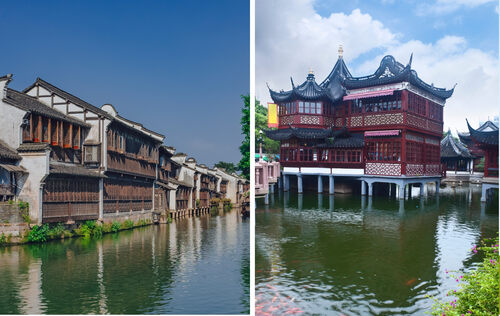
Shanghai vs Zhejiang: Zhejiang, a dynamic province in China, offers diverse employment opportunities in technology, manufacturing, trade, and tourism.
Similarly, Shanghai, China’s global financial hub, magnetizes job seekers with its thriving sectors like finance, technology, and manufacturing. Both regions pulsate with vitality, attracting talent from around the globe.
Moreover, multinational corporations, startups, and local businesses contribute to both regions’ dynamic job markets. Their presence amplifies the economic vibrancy and competitiveness of Shanghai and Zhejiang, making them prime destinations for career growth and professional opportunities.
Here are some more comparisons between Shanghai and Zhejiang:
Cost of Living Comparison
Zhejiang, China, boasts a moderate cost of living, with affordable housing, food, and transportation options, albeit pricey international schooling and healthcare.
In contrast, Shanghai is renowned for its high cost of living, particularly in the housing, dining, and entertainment sectors, yet offers accessible public transportation and groceries.
Despite these differences, both regions provide diverse lifestyle options catering to various budgets and preferences.
Income Disparity
Zhejiang, a thriving province in Eastern China, demonstrates a robust economy with a per capita disposable income of around 52,000 yuan in 2020, showcasing significant economic growth and improved living standards among residents.
Conversely, Shanghai, China’s economic hub, boasts a higher average annual disposable income of about 72,232 yuan in the same year, reflecting the city’s strong economic performance and elevated living standards, albeit with variances across sectors and job types.
Crime Rate and Safety Measures
Zhejiang, situated in eastern China, maintains a reputation for safety with its relatively low crime rate. Stringent law enforcement and community vigilance contribute to public security, although occasional minor crimes still warrant personal safety precautions.
While Shanghai, recognized as one of the world’s safest cities, boasts low crime rates and a robust surveillance system. While petty crimes like pickpocketing may occur, violent crimes are rare, allowing both visitors and residents to enjoy the city’s vibrant lifestyle with peace of mind.
Healthcare Facilities and Services
Zhejiang offers advanced healthcare facilities and services, featuring a network of public and private hospitals, clinics, and specialized health centers. With cutting-edge medical technology and highly skilled professionals, the province prioritizes patient care and integrates traditional Chinese medicine practices.
Similarly, Shanghai boasts advanced healthcare amenities, blending public and private hospitals to provide high-quality medical care. Staffed by internationally-trained professionals and equipped with modern technology, these institutions offer comprehensive healthcare services, catering to diverse medical needs.
Transportation Infrastructure

In Zhejiang, an advanced transportation system includes highways, railways, and airports, notably the Hangzhou Bay Bridge, the world’s largest sea-crossing bridge. Efficient public transit, such as metros and buses, ensures seamless local and intercity travel.
Shanghai’s transportation system is highly developed, featuring a comprehensive network of metro lines, buses, taxis, and ferries. With one of the world’s busiest ports and international airports, the city’s modern infrastructure facilitates smooth and convenient travel for both locals and tourists.
Housing Market Comparison
In Zhejiang, the housing market offers a diverse range of options, from high-end to affordable residences. However, rapid urbanization and economic growth have driven up prices, posing affordability challenges, particularly in major cities like Hangzhou.
Shanghai’s housing market is marked by high demand and limited supply, resulting in steep prices. Despite government initiatives to enhance affordability, securing reasonably priced housing remains challenging for both locals and expats.
While the high-end market thrives, the scarcity of affordable options underscores the pressing issue of housing accessibility.
Population Density and Diversity
Zhejiang, an eastern coastal province of China, sustains a population of roughly 57 million, with a density of 534 individuals per square kilometer, making it one of China’s most populous regions. The concentration of people in urban areas mirrors the province’s swift urbanization.
Conversely, Shanghai, China’s most populous city, hosts over 24 million inhabitants, boasting a high population density of about 3,800 individuals per square kilometer. This density underscores its significance as a global financial center and major shipping port.
Expat and Foreigner Communities
Zhejiang, a vibrant province in Eastern China, attracts a substantial expat and foreigner community, with over 90,000 estimated residents as of 2020. This diverse population enriches the province’s cultural tapestry and strengthens its global connections, highlighting Zhejiang’s international allure.
In contrast, Shanghai, a global hub, accommodates a sizable expatriate and foreign population, exceeding 200,000 residents as of 2020. Their presence enhances Shanghai’s cosmopolitan ambiance, contributing to its vibrant multiculturalism and reflecting the city’s status as a melting pot of diverse cultures.
Cultural Heritage and Tourist Attractions

Zhejiang, China, is renowned for its rich cultural heritage and breathtaking natural landscapes. Visitors are captivated by iconic destinations such as the tranquil West Lake, the ancient water town of Wuzhen, the sacred Buddhist temples of Mount Putuo, and the mesmerizing Three Pools Mirroring the Moon.
On the other hand, Shanghai, China’s vibrant metropolis, offers a different yet equally captivating experience. With iconic landmarks like the futuristic skyline of Pudong, the beauty of Yu Garden, the shopping paradise of Nanjing Road, and the charm of the Bund.
Its diverse cultural and architectural landscape promises an enriching journey for tourists seeking memorable experiences.
Tourist-Friendliness and Safety
Zhejiang, China, extends a warm welcome to tourists, boasting a perfect blend of rich cultural heritage and modern amenities. Safety is paramount, with a low crime rate and efficient local authorities ensuring visitors’ peace of mind.
The friendly locals further enhance the tourist experience by offering assistance whenever needed.
Similarly, Shanghai is renowned for its tourist-friendly environment, seamlessly blending modernity with tradition. The city prioritizes safety with a low crime rate and efficient public security measures.
English signage, helpful locals, and a reliable public transport system ensure seamless navigation for tourists, while prompt emergency services guarantee a secure visit.
Environmental Quality
In Zhejiang, China, the coastal province enjoys relatively good air quality, attributed to abundant greenery and stringent pollution control measures. However, industrial expansion presents environmental challenges, with varying water quality from pristine mountain streams to polluted urban waterways.
Contrastingly, Shanghai’s environmental quality fluctuates, with improvements in air and water quality, albeit air pollution occasionally surpasses WHO guidelines. Progress in water quality is noted, yet pollution in rivers like the Huangpu persists.
Shanghai continues its journey towards better environmental sustainability, acknowledging the work in progress.
Concluding Shanghai vs Zhejiang
In conclusion, both Shanghai and Zhejiang offer unique advantages and opportunities, each head to with its own distinct characteristics and attractions. While Shanghai shines as a global financial hub and bustling metropolis, Zhejiang boasts a rich cultural heritage and a vibrant economy.
Whether seeking dynamic urban experiences or tranquil natural beauty, both regions present enticing prospects for residents and visitors alike.
